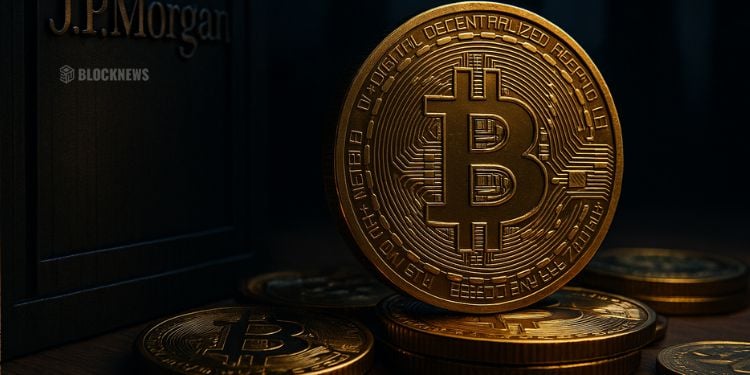- JPMorgan boosted its holdings of BlackRock’s IBIT spot Bitcoin ETF by 64%, now holding 5.28 million shares worth about $343 million.
- The move marks a big shift from CEO Jamie Dimon’s past anti-Bitcoin stance, showing JPMorgan is now actively offering regulated BTC exposure to clients.
- This comes as Bitcoin holds above the $100,000 support area, with spot ETFs cementing their role as the main institutional on-ramp into BTC.
JPMorgan Chase has disclosed that it now holds roughly 5.28 million shares of BlackRock’s iShares Bitcoin Trust (IBIT), a spot Bitcoin ETF, according to its latest 13F-HR filing with the U.S. SEC dated November 7. As of September 30, that position was valued at about $343 million, representing a massive 64% jump from the bank’s IBIT holdings in the previous quarter, when it reported about 3.2 million shares worth roughly $302.6 million.CoinDesk+1

This rapid accumulation signals that JPMorgan’s wealth and brokerage clients are leaning far more aggressively into regulated Bitcoin exposure than just a few months ago. Rather than buying spot BTC directly or dealing with private custody, they’re opting for a familiar market wrapper: an ETF that trades like a stock, settles through traditional brokers, and fits neatly into existing portfolio and compliance frameworks.
From “Bitcoin is a fraud” to “give clients the ETF”
Jamie Dimon, JPMorgan’s long-time chairman and CEO, has spent years trashing Bitcoin in public. He has called BTC a “fraud,” suggested the U.S. government should “shut it down,” and repeatedly linked crypto to criminal activity. Those comments helped cement JPMorgan’s reputation as one of TradFi’s fiercest crypto skeptics.
But the numbers on the 13F tell a different story. With the bank’s clients now sitting on hundreds of millions of dollars’ worth of IBIT, JPMorgan has effectively pivoted from blanket hostility to pragmatic monetization. Dimon hasn’t suddenly become a Bitcoin maxi, but the bank is clearly willing to offer Bitcoin exposure in a heavily regulated ETF wrapper where it can manage risk, earn fees, and keep clients from wandering off to nimbler competitors. The pace of IBIT accumulation suggests that high-net-worth and institutional clients are not only warming to Bitcoin, they’re actively scaling in.CoinDesk
Spot Bitcoin ETFs as the institutional on-ramp
Spot Bitcoin ETFs, approved in the U.S. in January 2024, have reshaped the institutional landscape. Products like IBIT let funds, pensions, family offices, and big-bank clients gain BTC exposure without setting up crypto wallets, integrating new custodians, or navigating the operational headaches of on-chain transactions. Unlike futures-based ETFs, these vehicles are backed by direct spot Bitcoin holdings, which means ETF demand translates into real buying pressure on BTC itself.coinglass+1
After an aggressive rally that pushed Bitcoin well into six-figure territory in 2025, spot ETFs became one of the main levers driving and absorbing liquidity. Even when the market hit turbulence and U.S. Bitcoin ETFs went through a brutal six-day outflow streak earlier in the year, that streak eventually snapped with hundreds of millions of dollars in fresh net inflows, led once again by BlackRock’s IBIT and Fidelity’s FBTC.Cointelegraph+1 That pattern — sharp corrections followed by renewed ETF dip-buying — is exactly the backdrop in which JPMorgan’s 64% IBIT position jump lands.
Bitcoin hangs onto six-figure support as ETF flows stabilize
Despite heavy volatility and a series of ETF outflow waves, Bitcoin has managed to hold a key six-figure support zone. Recent market data shows BTC trading in the low $100,000s, with many analysts eyeing the $102k–$103k area as a critical support band that could either springboard a relief rally back toward $110k or, if lost, trigger deeper liquidations.CoinMarketCap+1
At the same time, spot Bitcoin ETFs have started to show signs of stabilization, with renewed inflows after prior multi-day outflow streaks.Crypto News Flash+1 For institutions, this environment looks less like the speculative wild west and more like a maturing asset class with familiar plumbing: regulated funds, transparent flows, and deep secondary market liquidity. Against that backdrop, JPMorgan’s growing IBIT stack reads less like an outlier and more like the shape of the new normal — where even the loudest Bitcoin critics end up offering BTC exposure once the right wrappers, safeguards, and fee opportunities are in place.
What JPMorgan’s pivot really signals
The headline number — 5.28 million IBIT shares and a 64% increase quarter-over-quarter — is about more than just one bank’s trade. It’s a snapshot of a broader structural shift: Bitcoin moving from a fringe asset held by retail and early-stage funds to a portfolio building block distributed by the largest banks on earth.CoinDesk+1
Dimon’s earlier attacks on Bitcoin haven’t vanished, but they now coexist with a very real, very sizable ETF-based exposure on behalf of JPMorgan’s clientele. For the crypto market, that combination — public skepticism plus private accumulation through regulated channels — may actually be the most honest signal of where we are in the adoption curve. The narratives may lag, but the flows don’t lie.














